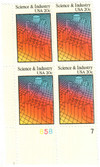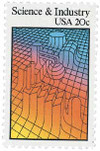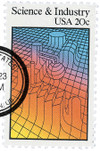
# 2031 - 1983 20c Science and Industry
20¢ Science and Industry
City: Chicago, IL
Quantity: 118,555,000
Printed By: Bureau of Engraving and Printing
Printing Method: Lithographed and engraved
Perforations: 11
Color: Multicolored
American Association for the Advancement of Science
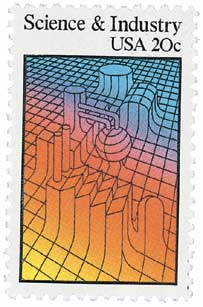
The American Association for the Advancement of Science (AAAS) was founded on September 20, 1848, in Philadelphia, Pennsylvania. It grew to become the world’s largest general scientific society with more than 120,000 members.
Prior to the founding of the AAAS, there had been other scientific organizations that were spread out across the country and were dedicated to specific scientific disciplines. On September 20, 1848, a group of scientists from the Association of American Geologists and Naturalists met at the Academy of Natural Sciences in Philadelphia, Pennsylvania. They reorganized their group as the AAAS, with the goal of promoting and representing science and engineering at the national level.
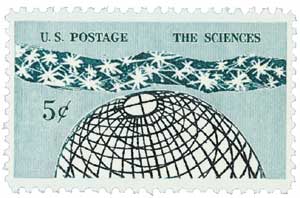
The founding members selected meteorologist William Charles Redfield as their first president, because he had presented the best plan for the new organization. They wrote their constitution at that first meeting, with the stated goal of encouraging scientific discussions that could lead to increased collaboration. By working together at the national level, they hoped to make scientific progress quicker and more efficient.
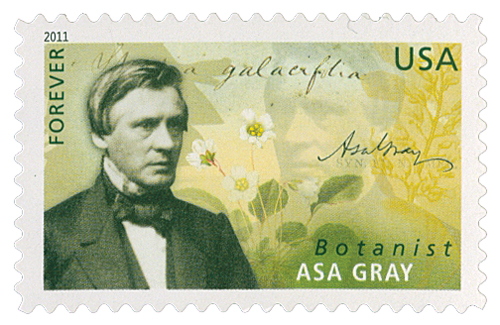
One of the first projects the AAAS took on was requesting nautical observations from other countries. At the time, many American navigators sent their logs to the US Naval Observatory, and some suggested that collecting similar information from other nations would benefit everyone.
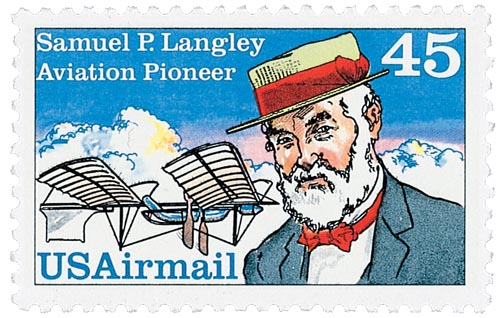
The AAAS admitted its first female members in 1850. By 1860, it had over 2,000 members. The outbreak of the Civil War postponed meetings until 1866. The organization continued to grow after that, admitting anyone to join, though a select few earned the title of “Fellow of the AAAS.”
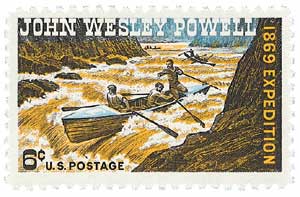
The journal Science was first founded in 1880 with financial support from Thomas Edison and Alexander Graham Bell. The journal struggled for many years, but in 1900, it became the official journal of the AAAS, benefitting both the journal and the organization. In 1907, the AAAS got its first permanent home at the Smithsonian Castle on the National Mall in Washington, DC. In the years to come, the AAAS created the Committee of One Hundred on Scientific Research, established Pacific and Southwestern Divisions, and created an annual “Thousand Dollar Prize” for young scientists that presented their research at AAAS meetings.
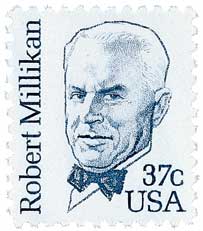
As other scientific organizations formed, the AAAS sometimes struggled, but it also invited them to become affiliates. Scientists such as Thomas Hunt Morgan, Albert Einstein, Barbara McClintock, and Edwin Hubble published in Science and spoke at meetings, helping to keep the AAAS at the forefront of the field. The AAAS also introduced programs to help improve public knowledge of scientific advancements.
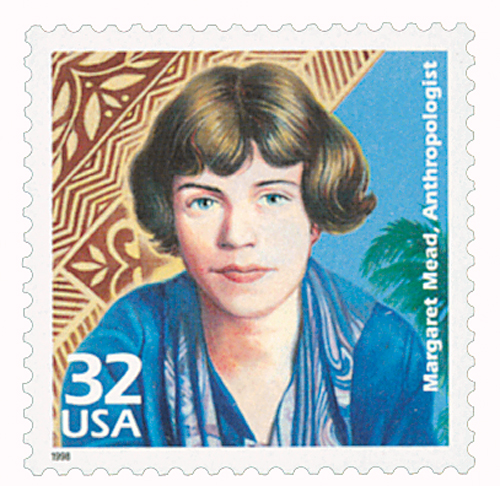
During World War II it created the “AAAS Bulletin” to keep its members informed when they couldn’t meet. In the 1950s and 60s, the AAAS developed its Science Teaching Improvement Program and formed the Commission on Science Education. They introduced the Scientific Freedom and Responsibility Award in 1981 to honor scientists who risked their lives or careers for ethical standards. The AAAS also influenced the passage of the Engineering Equal Opportunities Act, which ensured men and women from all backgrounds received the same opportunities.
Today the AAAS is the world’s largest multidisciplinary scientific society with over 120,000 members in 91 countries. They continue to promote scientific policies, international cooperation, STEM education, public involvement, and more. According to the AAS, “Most of all, we support science, technology, engineering and mathematics as solutions to many of the challenges the world faces today.”
20¢ Science and Industry
City: Chicago, IL
Quantity: 118,555,000
Printed By: Bureau of Engraving and Printing
Printing Method: Lithographed and engraved
Perforations: 11
Color: Multicolored
American Association for the Advancement of Science

The American Association for the Advancement of Science (AAAS) was founded on September 20, 1848, in Philadelphia, Pennsylvania. It grew to become the world’s largest general scientific society with more than 120,000 members.
Prior to the founding of the AAAS, there had been other scientific organizations that were spread out across the country and were dedicated to specific scientific disciplines. On September 20, 1848, a group of scientists from the Association of American Geologists and Naturalists met at the Academy of Natural Sciences in Philadelphia, Pennsylvania. They reorganized their group as the AAAS, with the goal of promoting and representing science and engineering at the national level.

The founding members selected meteorologist William Charles Redfield as their first president, because he had presented the best plan for the new organization. They wrote their constitution at that first meeting, with the stated goal of encouraging scientific discussions that could lead to increased collaboration. By working together at the national level, they hoped to make scientific progress quicker and more efficient.

One of the first projects the AAAS took on was requesting nautical observations from other countries. At the time, many American navigators sent their logs to the US Naval Observatory, and some suggested that collecting similar information from other nations would benefit everyone.

The AAAS admitted its first female members in 1850. By 1860, it had over 2,000 members. The outbreak of the Civil War postponed meetings until 1866. The organization continued to grow after that, admitting anyone to join, though a select few earned the title of “Fellow of the AAAS.”

The journal Science was first founded in 1880 with financial support from Thomas Edison and Alexander Graham Bell. The journal struggled for many years, but in 1900, it became the official journal of the AAAS, benefitting both the journal and the organization. In 1907, the AAAS got its first permanent home at the Smithsonian Castle on the National Mall in Washington, DC. In the years to come, the AAAS created the Committee of One Hundred on Scientific Research, established Pacific and Southwestern Divisions, and created an annual “Thousand Dollar Prize” for young scientists that presented their research at AAAS meetings.

As other scientific organizations formed, the AAAS sometimes struggled, but it also invited them to become affiliates. Scientists such as Thomas Hunt Morgan, Albert Einstein, Barbara McClintock, and Edwin Hubble published in Science and spoke at meetings, helping to keep the AAAS at the forefront of the field. The AAAS also introduced programs to help improve public knowledge of scientific advancements.

During World War II it created the “AAAS Bulletin” to keep its members informed when they couldn’t meet. In the 1950s and 60s, the AAAS developed its Science Teaching Improvement Program and formed the Commission on Science Education. They introduced the Scientific Freedom and Responsibility Award in 1981 to honor scientists who risked their lives or careers for ethical standards. The AAAS also influenced the passage of the Engineering Equal Opportunities Act, which ensured men and women from all backgrounds received the same opportunities.
Today the AAAS is the world’s largest multidisciplinary scientific society with over 120,000 members in 91 countries. They continue to promote scientific policies, international cooperation, STEM education, public involvement, and more. According to the AAS, “Most of all, we support science, technology, engineering and mathematics as solutions to many of the challenges the world faces today.”







